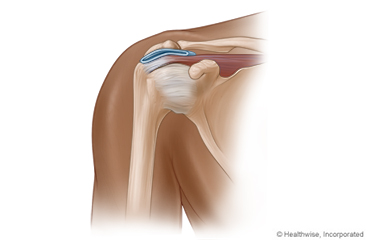
Overview
A shoulder separation is a tearing of the ligaments that connect two bones of the shoulder—the collarbone (clavicle) and the end of the shoulder blade (acromion). The ligaments can be partially or completely torn. This is usually caused by a blow to the top of the shoulder or a fall onto an outstretched arm.
Shoulder injuries can be slow to heal, but with time and effort, your shoulder should get better. Physical therapy can help you regain strength, motion, and flexibility in your shoulder.
Follow-up care is a key part of your treatment and safety. Be sure to make and go to all appointments, and call your doctor if you are having problems. It's also a good idea to know your test results and keep a list of the medicines you take.
How can you care for yourself at home?
- If your doctor put your arm in a sling, wear the sling as directed. Do not take it off before your doctor tells you to.
- Take pain medicines exactly as directed.
- If the doctor gave you a prescription medicine for pain, take it as prescribed.
- If you are not taking a prescription pain medicine, ask your doctor if you can take an over-the-counter medicine.
- Rest your shoulder as much as you can.
- Put ice or a cold pack on your shoulder for 10 to 20 minutes at a time. Try to do this every 1 to 2 hours for the next 3 days (when you are awake) or until the swelling goes down. Put a thin cloth between the ice and your skin.
- You may use warm packs after the first 3 days for 15 to 20 minutes at a time to ease pain.
- If your doctor gave you exercises to do at home, do them exactly as instructed.
- Do not do anything that makes pain worse.
- Go to all follow-up appointments. You and your doctor will decide if you need further treatment, including surgery. You and your doctor will also decide when to begin physical therapy, if it is needed.
When should you call for help?
Call your doctor now or seek immediate medical care if:
- Your pain gets a lot worse.
- You cannot move your arm.
- You have new weakness, numbness, or tingling in your hand or arm.
- Your arm or hand is cool or pale or changes color.
- Your sling feels too tight, and you cannot loosen it.
Watch closely for changes in your health, and be sure to contact your doctor if:
- You have new or increased swelling in your arm.
- You have new pain that develops in another area of your arm. For example, you have pain in your hand or elbow.
- You do not get better as expected.
Where can you learn more?
Go to http://www.healthwise.net/patientEd
Enter S051 in the search box to learn more about "Shoulder Separation: Care Instructions".
Current as of: July 17, 2023
Author: Healthwise Staff
Clinical Review Board
All Healthwise education is reviewed by a team that includes physicians, nurses, advanced practitioners, registered dieticians, and other healthcare professionals.

